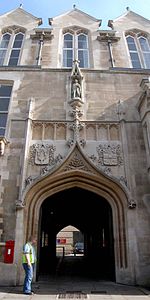Laboratorium Cavendisha

Laboratorium Cavendisha (ang. Cavendish Laboratory) – część struktury Uniwersytetu Cambridge stanowiąca jego wydział fizyki, utworzona w 1874 r. jako laboratorium przeznaczone do nauczania. Prowadzi się w nim badania m.in. w zakresie nadprzewodnictwa, mikroskopii elektronowej, radioastronomii, chemii oraz biologii (rentgenografia strukturalna).
Jednostka powstała na cześć Henry Cavendisha z funduszy Williama Cavendisha[1], fundatora i ówczesnego rektora uniwersytetu.
Historia
[edytuj | edytuj kod]Budowę budynku wydziału rozpoczęto w 1871 r., po wydaniu stosownej decyzji senatu uczelni w 1869 r. Otwarcie nastąpiło w 1874 r. Powstanie laboratorium nadzorował fizyk James Clerk Maxwell, który został także jego pierwszym kierownikiem. W roku 1974 Laboratorium przeprowadzono do nowych budynków w zachodniej części Cambridge.
Lista kolejnych kierowników Laboratorium Cavendisha:
- James Clerk Maxwell (1871–1879)
- Lord Rayleigh (1879–1884)
- J. J. Thomson (1884–1919)
- Ernest Rutherford (1919–1937)
- William Lawrence Bragg (1938–1953)
- Nevill Mott (1954–1971)
- Brian Pippard (1971–1984)
- Sam Edwards (1984–1995)
- Richard Friend (1995–)
Pracownicy
[edytuj | edytuj kod]Obecnym dyrektorem laboratorium, a jednocześnie szefem wydziału fizyki jest profesor James Stirling, specjalizujący się w teoretycznej fizyce cząstek elementarnych[2].
Pracownikami laboratorium było 29 laureatów Nagrody Nobla[3], m.in. Lord Rayleigh, J.J. Thomson, Ernest Rutherford, C.T.R. Wilson, Paul Dirac, Piotr Kapica, Lawrence Bragg, Max Perutz czy John Kendrew. Było ono także miejscem ustalenia struktury DNA przez Jamesa Watsona i Francisa Cricka w 1953 r.
Linki zewnętrzne
[edytuj | edytuj kod]Przypisy
[edytuj | edytuj kod]- ↑ The Times, 4.11.1873, s. 8
- ↑ Zarchiwizowana kopia. [dostęp 2011-07-19]. [zarchiwizowane z tego adresu (2011-07-19)].
- ↑ University of Cambridge: Educational Outreach at the Cavendish laboratory. Cavendish Nobel Website. [dostęp 2009-12-22]. [zarchiwizowane z tego adresu (5 lutego 2012)]. (ang.).
Text is available under the CC BY-SA 4.0 license; additional terms may apply.
Images, videos and audio are available under their respective licenses.
